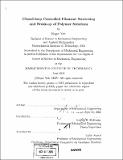Closed-loop controlled filament stretching and break-up of polymer solutions
Author(s)
Yeh, Roger, 1980-
DownloadFull printable version (12.84Mb)
Other Contributors
Massachusetts Institute of Technology. Dept. of Mechanical Engineering.
Advisor
Gareth H. McKinley.
Terms of use
Metadata
Show full item recordAbstract
A constant true (radial) strain rate filament stretching experiment has been the Holy Grail of extensional rheological studies. These experiments are performed on a Filament Stretching Extensional Rheometer (FiSER). A filament stretching experiment is the only direct way of measuring the extensional viscosity of a fluid. Previous attempts to achieve constant rate stretching have required tedious and iterative processes, which relied on the data of previous experiments to generate an axial profile that would result in a constant true strain rate experiment. This study presents a method to actively control the axial strains via the utilization of radial strain feedback. The first method we tried was an "Euler 1st order approximation," in which the ratio of the axial and radial strains is calculated at each time-step to determine the axial strain necessary at the next time-step to maintain a constant radial strain rate. This method worked, but was limited by how accurate this "ratio" of strains could be calculated. The "ratio" becomes unstable when the change in strain per time-step reaches the same order of noise. To fix this problem, we implemented a least squares linear regression scheme. (cont.) With this algorithm, we were able to reach radial strains of ... with strain rates of ... . Finally, we compared stretch-to-break (STB) experiments of a Newtonian fluid, styrene oil, to theoretical model. These experiments are also done on FiSER with the nominal strain rate held constant, generally very low (...). For a Newtonian fluid, the diameter decay can be determined analytically. We repeat the same with a weakly elastic fluid. STP® motor oil.
Description
Thesis (S.M.)--Massachusetts Institute of Technology, Dept. of Mechanical Engineering, 2005. Includes bibliographical references (p. 113-118).
Date issued
2005Department
Massachusetts Institute of Technology. Department of Mechanical EngineeringPublisher
Massachusetts Institute of Technology
Keywords
Mechanical Engineering.